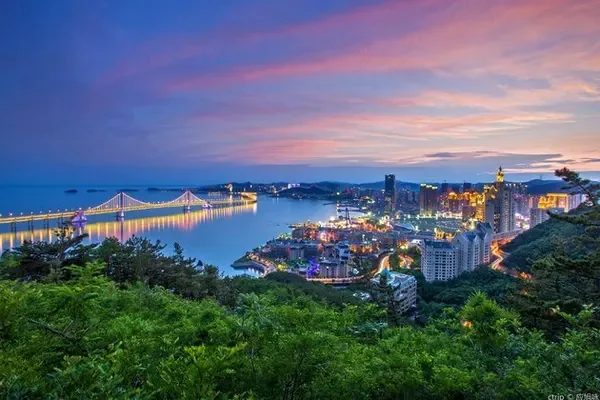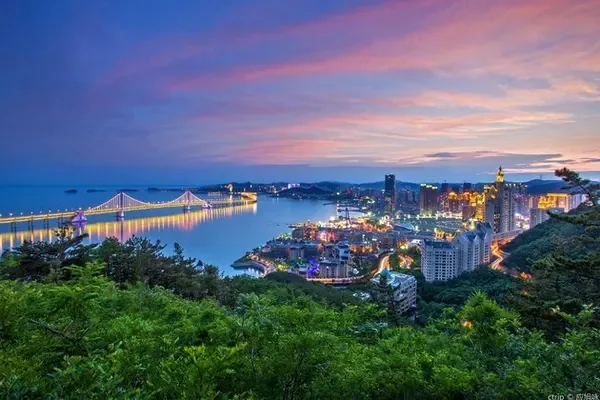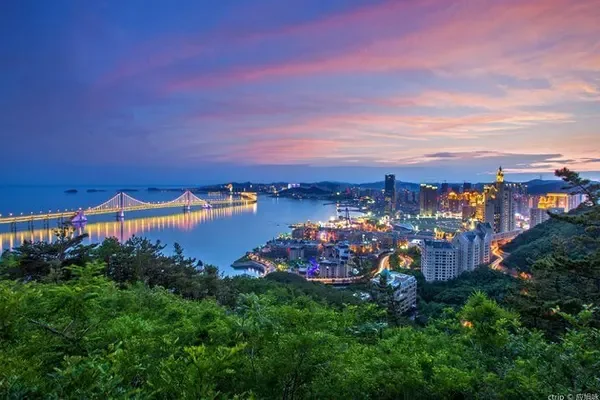There are countless natural beauties and places of interest in Beijing, but when it comes to the Cherry Valley in the West Mountain of Beijing, it is really unique. I remember that it was the beginning of autumn in 2008, and it was only one day before the opening of the Beijing Olympic Games. Because the meeting was held at the Reclining Buddha Villa in the Beijing Botanical Garden, the reporter and his party took leisure time to visit the nearby Xishan Reclining Buddha Temple and Cherry Valley. I didn't expect this trip to be a worthwhile trip, leaving very deep and beautiful memories.

When I woke up in the morning, there was already a bustling sound of birdsong outside. It is difficult to hear this kind of sound effect of a hundred birds singing at dawn in Beijing. The reporter and his party came to the Temple of the Reclining Buddha through the courtyard gate separated by a wall from the Temple of the Reclining Buddha.

There were very few tourists in the temple just after the door opened, and the staff were all cleaning everywhere in the temple. The reporter had been here a year ago, so he is more familiar with it. The temple was first built in the Zhenguan period of the Tang Dynasty (627-649). It was originally named Dousiate Temple, also known as Shou'an Temple. In the following dynasties, it was abolished and built, and the name of the temple also changed with the changes of dynasties. It was rebuilt in the 12th year of Emperor Yongzheng of the Qing Dynasty and renamed Pujue Temple. Because there was a reclining Buddha carved from sandalwood in the temple of the Tang Dynasty. Later, in the Yuan Dynasty, a huge bronze statue of Sakyamuni Nirvana was cast in the temple. Therefore, most people call this temple "the Temple of the Reclining Buddha".

According to the records of Yuan history: At that time, 500,000 catties of copper were cast and smelted, and 7,000 workers were employed. The Bronze Buddha is 5 meters long and sleeps in a horizontal position, with his head facing west and south, his left hand is naturally flat on his leg, and his right hand is bent to support his head. Sitting behind the reclining Buddha are 12 Bodhisattvas of Enlightenment. Their facial expressions are heavy and sad, forming a scene of Sakyamuni Nirvana under the Boluo tree, and telling 12 disciples what to do next.

On the front wall of the hall, there is a horizontal plaque that reads "Great Freedom". In addition, there are several Sala trees planted in the temple. At the end of spring and the beginning of summer, the white flowers are in full bloom. The flowers are like countless small white jade pagodas hanging upside down between the branches and leaves, which is very special. Since most of the reporter and his party had been to the Temple of the Reclining Buddha, they walked around the temple and took a few pictures before heading to Cherry Valley. After leaving the Temple of the Reclining Buddha, walk west along the corridor in the garden for a short distance and you will come to Cherry Valley. As a reporter who grew up in Beijing, this place used to be a frequented place when I was a student. But since I haven't been here for decades, my childhood memories of this place have long since disappeared. Today's Cherry Valley has a several-kilometer-long sightseeing plank road. The park is full of atmosphere and beautiful scenery. It is no longer the original wild scene when the reporter came here.

Cherry Valley is located in the northwest of the Reclining Buddha Temple. It is a quiet, secluded and full of natural wildness. It has been a scenic spot of Xishan since ancient times. Known for its wildness. The stream in the ditch is clear, there are many strange rocks, and the sound of birdsong adds to the quiet atmosphere of the valley. Cherry Valley has unique natural conditions and is a nature reserve with sound ecological functions in the suburbs of Beijing.

In the Ming Dynasty, Cherry Valley was once called "the end of the water", and in the Qing Dynasty, it was also known as "Tuigu" and "Zhou's Garden", but the name "Cherry Valley" was the most famous. According to legend, this place was originally a ravine rich in wild fruits, and there are many cherry trees in the ravine. Every spring, the cherry blossoms all over the mountain dye the whole valley red, and the fragrance of the flowers is intoxicating.

Jin Zhangzong, the sixth emperor of the Jin Dynasty, once built a flower viewing platform in Mizoguchi. "Ten thousand cherry blossom trees, the fragrance of spring comes" is still the word of mouth in those days. Now there are not so many cherry trees in the ditch, but the peak is high and the ditch is deep, the mountain is backed by the sun, the climate is warm and humid, the flowers and trees are luxuriant, the strange rocks are luxuriant, and the mountain springs are gurgling. People who are obsessed with returning to nature call this poetic name even more. Loud up. Metasequoia, known as the "living fossil" in Yingyinggou, has grown into a forest now, and there are also rare and endangered plants such as jade bell flower, green sandalwood, and red pine. vitality. It turns out that there are many places of interest here, such as Fangsheng Pond, Wansong Pavilion, Dapan Stone, Golden Pigeon Terrace, Shishangsong, Bailuyan, Bantianyunling, Tuiweng Pavilion, Shuangshi Cave, Yanerling, Yanxia Cave, etc. The Guanghui Temple built in 1442, the Longjiao Temple built in the 22nd year of Chenghua (1486), Wuhua Temple, Pufu Temple, Shuita Temple, Guanyin Pavilion and other ancient temples, but most of them no longer exist. .

Walk into Cherry Valley and walk on the long wooden plank road in the canyon, with beautiful and steep mountains on both sides, jagged rocks and deep mountain paths. The winding stream at the foot is crystal clear, and there are only dense metasequoia forests between the banks. The pine trees in the wilderness have different colors in four seasons, but the metasequoia is rusty red like fire in winter, light green like jasper in spring, tall and straight, with a vigorous temperament and charm.

The towering metasequoia meanders along the stream, and the zigzag plank road in the fir forest spirals up, and on the high place is a piece of green bamboo that is about to drip. You pull me in the clumps of green bamboos, and I am next to you, densely clustered into a forest. Looking around, it looks like a piece of emerald inlaid in the valley.

Although it is just the beginning of autumn, there are already gusts of mountain wind blowing gently in the ditch in the heat of summer, and the bamboo forest is rustling, like a lady playing the piano, like a lover whispering, it is extraordinarily charming and gentle. The dense bamboo forest is like a huge green barrier, blocking the heat outside, making people feel like they are in a cool world.

Walking in the ditch, there are endless springs flowing under your feet. Taste the cool spring water in Cherry Ditch, and listen to the magical legends of "Pine on the Stone" and "Gemstones in Yuan", which will make you realize that "walking to the poor place of water, Sit and watch the clouds rise" beautiful artistic conception. On the hillside at the entrance of Cherry Valley, there is a ruined site with only ruined steles. This is the ruins of Longjiao Temple, which was very prosperous in Yuan Dynasty. The incense of that year has been blown away by the rain and the wind, and even the Buddhists who are pure-hearted and ascetic can't help but sigh the vicissitudes of life. Sun Chengze, a famous scholar in the early Qing Dynasty, once built a "Tuiweng Pavilion" on the west side of Longjiao Temple, and "Tianfu Guangji" was born in this beautiful water and mountains surrounded by cherry blossoms.

Walking along the stone steps, you can only see dangerous peaks facing each other in front of you, and the steep walls are like cuts. On the steep cliffs, there are eight seal characters engraved with "Luyan fairy trail, retreating valley and secluded habitat". This is the famous Golden Pigeon Terrace. The tall mountain walls are covered tightly by trees, just like a painter overturned the palette, soaking up and down the mountain with fragrant oil paint, paving the small valley with green.

Every time after the rain, the mountains and rivers converge, and the huge waterfall will flow straight down from the cliff, billowing, spraying fog, roaring loudly, and the crystal clear stream rolls and moves under people's feet like a silver chain. Where the stream is turbulent, flying beads splash jade, sparking bright water splashes; when the stream is gentle, "the sound of springs swallowing dangerous stones", the water surface ripples with soft water patterns like oil.

A white marble stone bridge moved from Duanwang Mansion crosses the creek, but on the railing of the bridge is the word "Red Star Bridge" inscribed by Guo Moruo. The ancient stone bridge has a modern name. I feel that there is a lack of harmony with the environment. There are not many ways to cross the bridge, and you will see the stone gate of "Luyan Jingshe". Outside the gate is the stele "Tuigu" written by Liang Qichao.

Photo of Cherry Groove
Deer Rock, also known as Bailu Cave, is 6 meters deep and 2 meters long, and can accommodate one or twenty people, with a stone bed inside. It is said that in the Liao Dynasty, a fairy riding a white deer traveled here and was infatuated with the scenery of mountains and rivers, and took this as his home. Within the stone gate of "Luyan Jingshe" is the Cherry Valley Garden, which is "a valley with a path leading to a secluded, unique place".

The garden is famous for its small name, but it is a scenic spot that condenses the natural scenery of Cherry Valley. On both sides of the winding path, exotic flowers and grasses, lush trees and bamboos are densely covered with the mountains; in the depths of the green shade, there are huts and pavilions dotted with the layout.

The "December 9th" Movement Memorial Pavilion is located opposite the "Defense of North China" stone carving, in a stone square courtyard facing each other across a ditch. Eight large gold-plated characters were inscribed by Peng Zhen, chairman of the Standing Committee of the National People's Congress. The commemorative inscription written by the Beijing Municipal Committee of the Communist Youth League and the Beijing Federation of Students was written by the famous calligrapher Liu Bingsen. The memorial pavilion is on the south side of the monument, and was built with donations from the Beijing Municipal Committee of the Communist Youth League and the Beijing Student Union. The memorial pavilion is composed of three triangular pavilions. The idea is: the triangle is the epitome of the camping tent when the "December 9th" movement held a military summer camp. The three triangles form a three-dimensional "public" character, implying the awakening of the general public and the people's determination to resist aggression as one. The tall and straight architectural lines symbolize the vigorous and positive spirit of youth. The three groups of buildings, large and small, indicate that the revolutionary tradition has been passed down from generation to generation, and the revolutionary cause has been succeeded by others.

After passing the "December 9th" Memorial Pavilion, you will arrive at the "Water Source". But seeing a huge stone in the way, it seems to fall from the sky. The boulder is about four feet long, two feet wide, and one foot high. It is round and shaped like an ingot. Two big brown characters "source" are engraved on the stone. As the name suggests, "the source of water" is the source of the stream in Cherry Valley.

The spring water flows out from the crevices of the rocks and merges into the pool. The rushing stream is such a source of dripping water and a river of confluence. No wonder the stream in Cherry Ditch is so clear, cool and sweet. "Ask where the canal is?" If you are clear like this, you will have a source of living water!" Take the road from the source of the water to the mountain, and you can reach the peak of "Half-Tian Yunling" and Heilongtan. There is a couplet in the pavilion saying: "Walk to the place where the water is poor, and sit and watch the clouds rise." Therefore, the spring is called the source of water, and the mountains are called Bantianyun, which are two scenic spots in the ditch. Standing on the top of the mountain and looking far away, it should be a lot of fun.

The taste of Cherry Valley is not only the scenery of mountains and waters, the water source of Yunling, but also the original trees and flowers, which are full of green fields. The taste of Cherry Valley has its own uniqueness, that is, the unique "Story of Stone" culture of Cherry Valley . Legend has it that when Cao Xueqin conceived "A Dream of Red Mansions", Yingyinggou was a place he often visited to wander around and seek dreams and wonders. The beauty of heaven and earth inspired his eternal talent, and the beauty of mountains and rivers spread out the splendor in his heart. Since the Ming and Qing Dynasties, this place has been a place where celebrities and scholars lived in seclusion. Near Yingyinggou, there are the former residence of Zhou Yangan, a famous painter of the Qing Dynasty, and the former residence of Cao Xueqin, a great writer. In recent years, while enjoying the beautiful natural scenery here, tourists also remember and appreciate the literary and erudition of ancient famous scholars... (Photo: Feng Ganyong)


